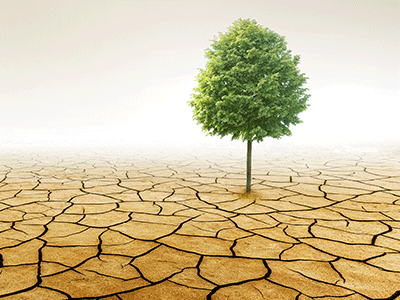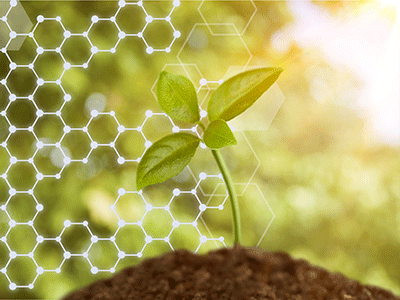How we feed the world today
How we feed the world today
Tambien disponible en español | Egalement disponible en français
Food & agriculture: a (very) brief history
From hunting and gathering to modern day food, agriculture and fisheries value chains, fears that food production could not keep up with population growth have pre-occupied mankind. Thomas Malthus, in his famous Essay on the Principle of Population (1798), predicted mass starvation that would only be corrected by war and pestilence, thus reducing the population to a more manageable size.
In reality, farmers and fishers have continuously increased production, more than keeping pace with population and income growth. At first, farming (and fishing) activities were expanded onto more and more land (and water). Around the middle of the twentieth century, food production and agricultural land use became increasingly independent: between 1960 and today, world population more than doubled, global food production more than tripled, and agricultural land use increased by less than 15%.
Farmers intensified production by using better inputs, such as synthetic fertilisers, improved varieties, and crop protection chemicals and by adopting better management practises, such as crop rotation to sustain soils and irrigation to improve water use. Fisheries exploited new technologies, and increasingly aquaculture, to increase global fish production. These innovations allowed more to be produced using the same amount of land and water, though too often contributing to pressures on sustainable use of the natural resource base.
The world population doubled over the last 50 years to 7.5 billion people, while the share of the population suffering from food and nutrition insecurity fell from 15% in 2000 to around 11% today. While an unacceptably high 820 million people are still food insecure, it is not because food is not available. The root cause of hunger and malnutrition today is poverty – often exacerbated by conflict – that inhibits access to food.
Feeding the world today
The conditions in which food are produced vary tremendously across the world. In advanced countries, technological innovations are bringing high-tech solutions to many farms. At the same time, small farms with less than two hectares of land represent 84% of farms globally, but produce only one-third of global crop production. Farmers and fishers operating on a small scale seldom have either the resources or the education to access the latest technologies, and often hesitate to try new approaches they perceive as too risky to their own food security and livelihoods.
Following the widespread uptake of aquaculture production, particularly in Asia, almost 60 million people work in the fisheries and aquaculture sector today, almost twice as many as in the early 1990s. At the same time, global seafood consumption has grown more rapidly than all other meats combined. Food production per farmer has also increased strongly, while the share of the global population working in agriculture has fallen. Today, agriculture accounts for only 3% of total employment in high-income countries, but over 40% in some major emerging economies such as India, and an even higher total in some less developed economies, including many in Africa.
Producing food has always been a risky business. Crop production depends on good quality soil and water, along with predictable weather and a sufficient growing season, while livestock disease can cause major harm to human and animal health. Drought can lead to supply shortages, and fluctuations in exchange rates or new trade restrictions can contribute to price volatility. These risks directly affect the economic returns from agriculture, impacting the livelihood of farmers.
The challenges facing the food, agriculture and fishery sectors will increase with climate change. Global average temperatures have been setting new records almost every year, while rain has become less reliable. Extreme weather events that destroy crops – like floods, droughts and large storms – have become more common. Pests, weeds, viruses and disease move to new areas and affect crops, livestock and aquaculture production. Climate change is also altering the productivity of capture fisheries and the distribution of fish stocks, making future harvests less certain.
Despite all of these uncertainties, food prices have significantly decreased over the long run as growth in production exceeded growth in demand. But in 2007-2008 spikes in food prices, due to a virtual ‘perfect storm’ of factors (poor harvests, low stocks, export restrictions, etc.), were followed by a period of relatively high price volatility. A decade later, conditions on world agricultural markets are very different, and real prices for almost all commodities are expected to resume their long term trend downwards over the coming decade.
So where does my food come from?
Global food, agriculture and fishery systems are incredibly diverse. While regions like North and South America have a lot of agricultural land, and have emerged as major agricultural exporters, other regions such as the Middle East and North Africa have relatively little agricultural land and water. In addition, many agricultural products only grow in specific climates or soils. Developing countries, like China and Viet Nam, have displaced advanced economies as the major source of fish products globally.
As a result, trade in food, agriculture and fisheries products has never been as important as it is today. Much of the food we eat each and every day arrives to our grocery stores, restaurants, refrigerators and plates thanks to trade. Consumers enjoy fresh fruit and vegetables out of season, and have access to meat and fish from foreign fields and oceans.
Today, a small number of countries account for a large share of exports of some agricultural commodities, reflecting strong comparative advantage in production. For example, five countries account for more than two-thirds of the global wheat and beef exports. For soybeans the share exceeds 90%. Even for commodities where the share of the five main exporters is more modest, a single country often dominates, as in the case of sugar (Brazil accounts for 45% of global exports), oilseeds (Canada accounts for 54% of global exports), roots and tubers (Thailand accounts for 56% of global exports), and several dairy products.
Compared with exports, agricultural imports are typically less concentrated, with trade flowing from a small number of exporters to a larger number of importers. Notable exceptions are soybeans and other oilseeds, roots and tubers, and other coarse grains, where demand from China dominates.
At the same time, the emergence of global value chains (GVCs) has increased the interconnectedness of our economies, as various stages of production of the food we eat and the clothing we wear take place in different countries around the world. This creates potential new opportunities, but also challenges, for farmers and fishers to benefit from indirect access to global markets, by participating directly in domestic value chains. The nature of consumer demand is also changing, again creating both new opportunities and challenges for primary producers and downstream food processors and distributors.
Since the time of Malthus, the global food system has responded to the needs of a growing and more affluent world population. But farmers and fishers operate in a world of constant change, and the pace of change is increasing. Governments have an important role to play to ensure that its policies, institutions, and infrastructure are fit for purpose, providing the enabling environment for the sector to be increasingly productive, sustainable, resilient and responsive to consumer demand.
What governments are doing
Government policies and interventions play a major role in shaping food and agriculture markets, but policies are not always well aligned to evolving objectives.
Opportunities and threats to food systems
Resource depletion and climate change pose major challenges to the global food system, but there are opportunities for policy to help address these challenges.
What is the future of food and farming?
How the global food, agriculture and fisheries system evolves in coming decades will depend on targeted measures to ensure that no one is left behind.


